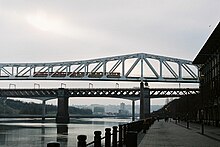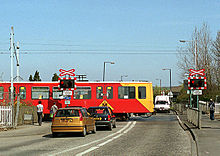Tyne and Wear Metro
| Tyne and Wear Metro | |
|---|---|

|
|

|
|
| Basic information | |
| Country |
|
| city | Newcastle |
| opening | August 11, 1980 |
| operator | DB Regio Tyne & Wear Ltd. ( Arriva ) |
| owner | Nexus |
| Infrastructure | |
| Route length | 74.5 km |
| Gauge | 1435 mm ( standard gauge ) |
| Power system | 1500 V DC |
| Stations | 60 |
| business | |
| Lines | 2 |
| Cruising speed | 80 km / h |
| statistics | |
| Passengers | 109,600 per day (2015) |
| website | |
| nexus.org.uk/metro | |
 Route map |
|
The Tyne & Wear Metro , opened in 1980, is an urban rail system in the Newcastle area . So the train connects u. a. Newcastle, Gateshead , Sunderland , South Shields , Tynemouth and Whitley Bay together. The metro is named after the metropolitan county it serves Tyne and Wear , whose name is derived from the rivers Tyne and Wear that cross the metropolitan area. The Tyne & Wear Metro combines features of different rail transport systems, in the city center of Newcastle it presents itself with the tunnel sections as a full-fledged underground train , the intersection-free routes outside the tunnel to the outskirts correspond to modern light rail vehicles on the outside routes previously operated by the railroad However, there are several level crossings and sections served jointly by regional trains, so that there it corresponds more to an S-Bahn . Major routes emerged from the reconstruction of the original railway lines, which gradually became less attractive over time.
history
Construction began in August 1974 after the British government approved the construction of the metro at Haymarket station . On August 11, 1980, the first line of the Tyne & Wear Metro between Haymarket and Tynemouth opened, regular operations began four days later. On May 10, 1981, a branch of the existing line between South Gosforth and Bank Foot went into operation with a ten-minute train interval. On June 8, 1981, the extension of the main line by six stations from Haymarket to Heworth was put under tension and opened on November 6, 1981 by Queen Elizabeth II . It crosses the River Tyne on the newly built Queen Elizabeth II Bridge.
On November 14, 1980, a very significant extension of the future ring line to St. James went into operation. Because this created a strange situation: the line crossed itself at the Monument station and was not a ring line because there was no rail connection with passenger traffic there.
In 1984, the conversion of the railway line to South Shields , which was closed on June 1, 1981, was completed in the south , this section of the route is now used by the yellow line. In 1991 the metro was extended in the northwest to Newcastle Airport , and in 2002 in the south to the city of Sunderland to South Hylton station .
Ridership grew due to the privatization of the public transport is not as desired. While many bus routes were previously broken at transfer stations to the Tyne & Wear Metro , many bus routes were then continued directly into the city center of Newcastle. Due to these direct connections, the metro was deprived of many passengers who preferred the bus transport without changing trains. This was of course also reflected in the timetables, because partial lines were deleted and clocks thinned out. At first there was a blue line that ran from St. James via Monument and Wallsend to North Shields and strengthened the yellow line on this route. A red line ran between Benton and Pelaw as a further compression of the yellow line. A train came every 5 minutes on the reinforced sections during rush hour .
In 1996/1997 the yellow and green lines were still running, as well as the red line on Saturdays during business hours. On weekdays, a clean 10-minute cycle was run during the day, every 7½ minutes during rush hour and every 15 minutes during off-peak hours and every 15 minutes on Sundays (sometimes every 12 minutes). On Sunday mornings the train sequence is 30 minutes. So there were more trains between Pelaw and South Gosforth on Saturdays than during the weekday rush hour. In 2008, the trains ran every 12 minutes during the day on weekdays, but somewhat compressed during rush hour. An exact cycle cannot be specified here, as the overlapping with regional trains on the Sunderland route results in unequal cycles.
Lines
Two lines with a total length of 74.5 km and 60 stations are currently in operation.
| line | colour | route | opening | Stations |
|---|---|---|---|---|
| Yellow Line | yellow | St. James - Monument - Wallsend - North Shields - Whitley Bay - South Gosforth - Monument - Gateshead - Heworth - South Shields | from 1980 | 42 |
| Green Line | green | Airport - South Gosforth - Monument - Gateshead - Heworth - Sunderland - South Hylton | from 1984 | 31 |
The depot, from which most trains are used, is located north of South Gosforth station .
renovation
After more than 30 years of operation on the metro network, an extensive renovation program is currently taking place. Under the motto "Metro: all change", GBP 385 million is to be invested in the system, which transports over 40 million passengers annually . This includes route renewal with embankment fortification work, track and signal renewal and reconstruction of older bridges and stations, and in some cases also the widening of side platforms. The 225 ticket machines at the stations will be replaced by new models with touch screens , which can also be used to top up the newly introduced SmartCard called "Pop" from the NESTI system (North East Smart Ticketing System) for the entire region. New barriers are to be installed at the 13 most important stations.
vehicles
Previous
From Metro-Cammell in Birmingham were from 1975 to 1981 a total of 90 six-axle, two-piece high-floor - articulated railcars built, which some technical structures of the German rail vehicles B is based. The two prototypes (4001 and 4002) and 88 series cars (4003 to 4090) are operated with direct current (driving voltage 1500 volts), which they draw from an overhead line . While initially single wagons were used every ten minutes, which were often overcrowded, since 1981 all courses have been running in double traction .
In the case of overpasses, however, individual units and triple tractions also run (the tunnel stations are long enough for this in the shell, but are usually only equipped for the length of the double trains). The bidirectional vehicles are 27.43 m long and 2.7 m wide, can travel a maximum of 80 km / h (the Tyne & Wear Metro shows in km / h and not mph!) And have inductive train control .
Due to the age of the cars, refurbishment began in the mid-1990s, including freshening up the interior. By eliminating some of the seats in the area of the joint, generous catchment areas were created and the previously somewhat cramped situation was significantly improved. In order to be able to use the vehicles for another 15 years until 2025, they were subjected to an extensive overhaul between 2010 and 2015. New metro vehicles are to be ordered and delivered after 2021. The way to the financing (337 million GBP) was secured in November 2017.
Vehicles designed by the same manufacturer for the Hong Kong metro were tested on the Tyne and Wear metro network .
The dispatch signal was typical for TWM for a long time: a horn, followed by “Stand clear of the doors please!” In the local accent. This developed into a trademark that was even reflected in a piece of music. The digitally stored signal "doors closing" has been used since 2004, but has been gradually replaced by a simple signal tone similar to the door closing signal in the London Underground in the cars that have been modernized since 2011 .
New vehicles
Stadler is supplying 42 metro trains to Tyne & Wear Metro, building a new maintenance facility and taking over maintenance of the trains for 35 years. The order volume for trains, depot and maintenance amounts to around 700 million British pounds.
Web links
- The official metro site
- The official operator site (NEXUS)
- The Tyne and Wear tariff association
- Tyne & Wear Metro fansite
- The Tyne & Wear Metro at Urbanrail.net
Individual evidence
- ↑ a b Short messages in: Der Stadtverkehr 7/1981, p. 308 f.
- ^ A b Extension of the Tyne & Wear Metro in: Der Stadtverkehr 2/1982, p. 64.
- ^ The "Newcastle" light rail has started operations in: Der Stadtverkehr 11-12 / 1980, p. 495
- ↑ Metrofutures: An essential new train fleet . Accessed November 22, 2017
- ^ Funding new Metro fleet: A message from Nexus . Accessed November 22, 2017
- ^ Stefan Göbel: New trains for Tyne & Wear Metro and Merseyrail . In: City traffic . tape 65 , no. 6 , June 2020, ISSN 0038-9013 , ZDB -ID 242252-9 , p. 16-21 .








